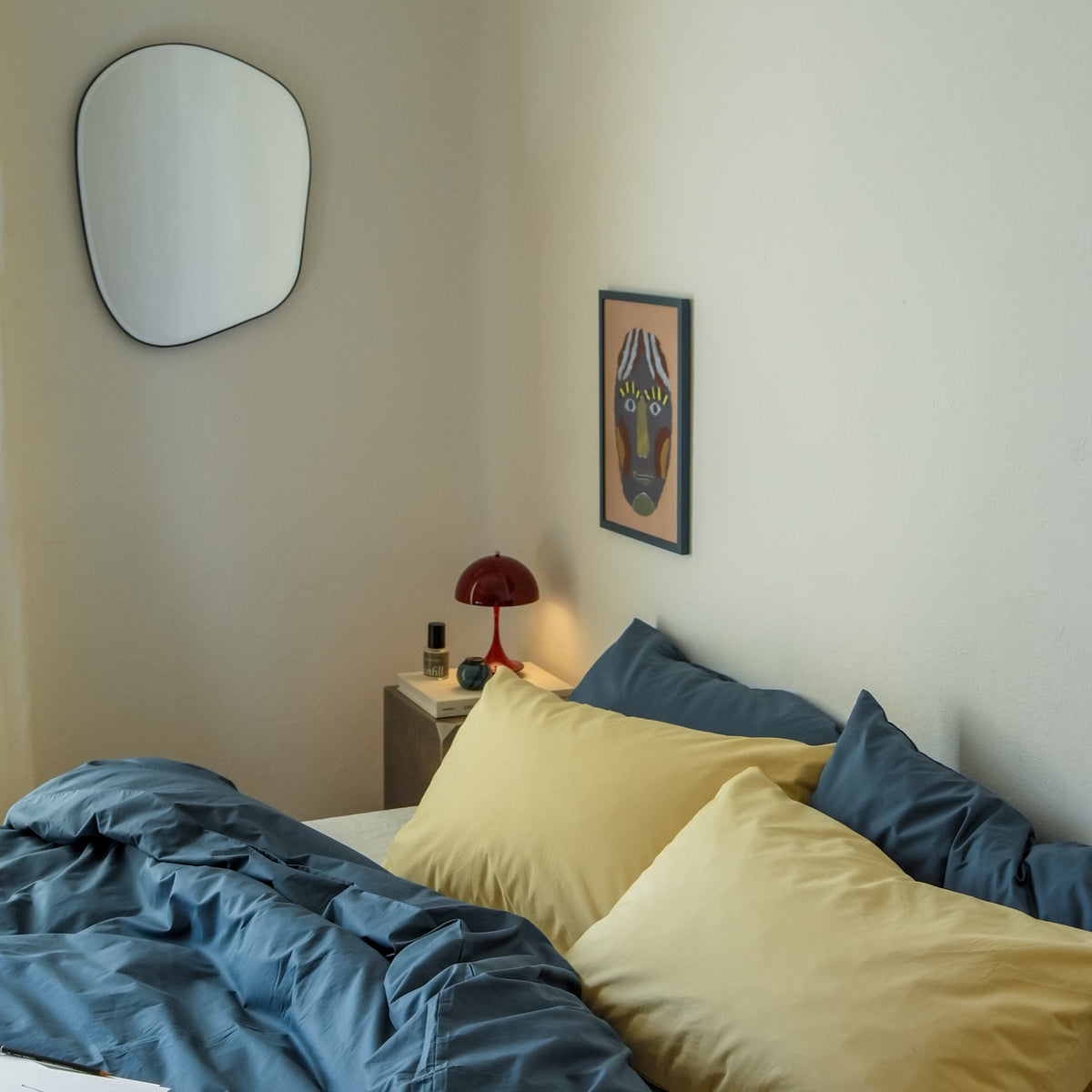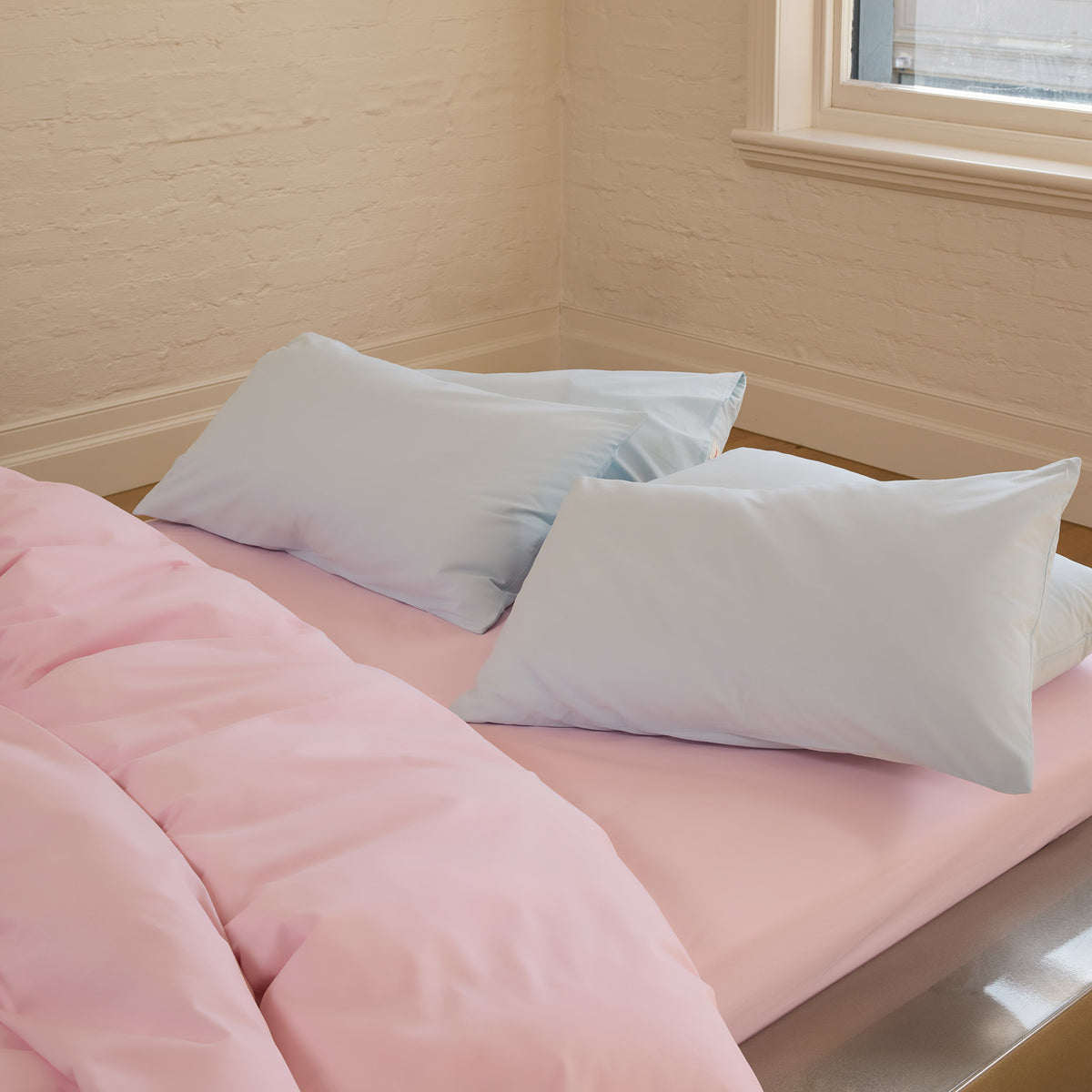We’re officially out of the winter woods and in our second month of spring. It does come with a cost though. Deep in allergy territory. If you’re waking up sneezing, itchy, or with puffy eyes, your bedroom might be part of the problem. That’s exactly why we designed our range of hypoallergenic doonas and cotton bed sheets, to help you breathe easier and sleep better. Sneeze, itch and cry no more.
Understanding Allergens in the Bedroom
Most people associate allergies with the outdoors, pollen, fresh cut grass or dusty corners. But many of the most stubborn triggers are hiding in plain sight, right in your bedroom. (Dun dun dun).
Common Culprits: Dust mites, pet dander, mould, and pollen are the biggest bedroom offenders.
Where They Lurk: Your mattress, quilt, pillows, and even sheets can become a haven for allergens if they’re not made with the right materials.
The Impact: Poor sleep, constant irritation, and that heavy-headed feeling in the morning are all signs your bedding could be making allergies worse.
Key Features of Allergy-Friendly Bedding
Hypoallergenic Materials
(Hypoallergenic Bedding)
“Hypoallergenic” simply means less likely to cause an allergic reaction. Choosing the right fibres and fillings makes all the difference.
-
Cotton: Is a natural, breathable fibre that’s gentle on sensitive skin and easier to keep clean than synthetics.
-
Bamboo: Naturally moisture-wicking, and silky-soft, good for sleepers who need comfort and allergy protection.
Dust Mite Barriers
(Dust Mite Proof Bedding / Allergy Barrier Bedding)
The tighter the weave, the better the protection. Dust mite-proof bedding uses dense fabrics that keep allergens from penetrating. Look for:
-
Mattress and pillow protectors with secure closures (look for deep envelopes or button closures).
-
Quilts designed to prevent dust mites settling inside.
Washability and Care
The key to keeping allergens away is regular washing at high temperatures. Bedding that can withstand hot cycles (60°C or higher) is essential.
-
Cotton and bamboo sheets: machine washable and durable.
-
Quilts and doonas: check care instructions, but Bonny’s are designed with easy-care in mind.
Choosing the Right Bedding Items for Allergies
Mattress
A mattress can quietly collect allergens over time, especially if left unprotected. Investing in a mattress made with hypoallergenic materials can help reduce reactions, but even if your mattress isn’t allergy-friendly on its own, you can still make it work for you. A dust mite-proof protector is one of the most effective ways to block irritants while extending the life of your mattress.
Pillows
Because your face spends hours (and hours) pressed against a pillow, the filling matters a great deal. Hypoallergenic fillings like memory foam, latex, or specially designed synthetics are less likely to trigger reactions compared to feathers. Protectors are just as important here as they are for mattresses, dust mite-proof pillow protectors keep irritants from settling in and give you an extra layer of reassurance.
Sheets
Sheets sit directly against your skin, which makes them one of the most important bedding items to get right. Natural fibres like cotton and bamboo are ideal for allergy sufferers because they’re breathable, washable at higher temperatures, and less likely to harbour irritants than synthetics. They’re also soft and lightweight, helping you stay comfortable as the weather warms.
Quilt
Quilts can be trickier for allergy sufferers, since some fillings can cause sensitivities. Down and feather quilts are luxurious and insulating, but may not suit those with allergies—even though at Bonny, our down is carefully cleaned and filtered to remove irritants. Wool is a strong alternative, as it’s naturally hypoallergenic and resistant to dust mites while also regulating temperature throughout the night. Cotton-filled quilts are another excellent choice, being lightweight, breathable, and easy to wash.
Tips for an Allergy-Free Sleep Environment
Creating an allergy-friendly bedroom goes beyond just your bedding. Small habits can make a big difference.
-
Wash all bedding weekly in hot water.
-
Use allergen-proof protectors on mattresses and pillows.
-
Vacuum regularly with a HEPA filter to trap allergens.
-
Keep humidity low to prevent mould.
-
Consider an air purifier to filter pollen, dust, and dander.
-
Keep pets off the bed if you’re sensitive to dander.
Finding Allergy-Friendly Bedding at Bonny
Finding Allergy-Friendly Bedding at Bonny
We believe everyone deserves a healthy night’s sleep. That’s why our doonas and sheets are thoughtfully designed with allergy sufferers in mind.
From hypoallergenic cotton and bamboo sheets to carefully crafted quilts with dense outer shells, our bedding helps you rest easier, without compromise.
We’re officially out of the winter woods and in our second month of spring. It does come with a cost though. Deep in allergy territory. If you’re waking up sneezing, itchy, or with puffy eyes, your bedroom might be part of the problem. That’s exactly why we designed our range of hypoallergenic doonas and cotton bed sheets, to help you breathe easier and sleep better. Sneeze, itch and cry no more.
Understanding Allergens in the Bedroom
Most people associate allergies with the outdoors, pollen, freshly cut grass, and dusty corners. But many of the most stubborn triggers are hiding right in your bedroom.
Dust mites are the most common culprit, thriving in warm, humid spaces like mattresses, quilts, and pillows. Pet dander easily clings to fabric, mould spores can develop in damp bedding that hasn’t dried properly, and even pollen can settle into sheets after being carried indoors on hair or clothing.
Because we spend about a third of our lives in bed, the build-up of these allergens can have a big impact. Interrupted sleep, morning congestion, itchy eyes, and that heavy “allergy fatigue” feeling are all signs that your bedding could be making things worse.
Key Features of Allergy-Friendly Bedding
These insider tips can dramatically improve your sleep quality and extend the life of your bedding:
-
Hypoallergenic Materials
“Hypoallergenic” simply means less likely to cause an allergic reaction. Choosing the right fibres and fillings makes all the difference.
- Cotton: Is a natural, breathable fibre that’s gentle on sensitive skin and easier to keep clean than synthetics.
Bamboo: Naturally moisture-wicking, and silky-soft, good for sleepers who need comfort and allergy protection.
- Cotton: Is a natural, breathable fibre that’s gentle on sensitive skin and easier to keep clean than synthetics.
-
Dust Mite Barriers
The tighter the weave, the better the protection. Dust mite-proof bedding uses dense fabrics that keep allergens from penetrating. Look for:
- 1. Mattress and pillow protectors with secure closures (look for deep envelopes or button closures).
2. Quilts designed to prevent dust mites settling inside.
- 1. Mattress and pillow protectors with secure closures (look for deep envelopes or button closures).
-
Washability and Care
The key to keeping allergens away is regular washing at high temperatures. Bedding that can withstand hot cycles (60°C or higher) is essential.
Cotton and bamboo sheets: machine washable and durable.
Quilts and doonas: check care instructions, but Bonny’s are designed with easy-care in mind.



Tips for an Allergy-Free Sleep Environment
Creating an allergy-friendly bedroom goes beyond just your bedding. Small habits can make a big, big difference.
- Wash all bedding weekly in hot water.
- Use allergen-proof protectors on mattresses and pillows.
- Consider an air purifier to filter pollen and dust.
- Keep pets off the bed if you’re sensitive to dander.
Making up with sniffles or itchy skin shouldn’t be part of your morning routine, and the right bedding can make all the difference. That’s why our doonas and sheets are made with allergy sufferers in mind, helping you feel clear, comfortable and rested.
Our cotton and bamboo sheets are naturally hypoallergenic and gentle on sensitive skin, while still feeling soft and breathable through the seasons. The doonas are finished with a tightly woven outer shell, designed to keep dust mites and allergens out while still feeling light and cloud-like on your body. Every detail is carefully considered so you don’t have to choose between comfort and a healthier sleep.
We spend a third of our lives in bed, so it’s worth finding bedding that truly looks after you. At Bonny, we make it easier to create a space where you can breathe deeply, relax fully and wake up feeling like yourself again.









